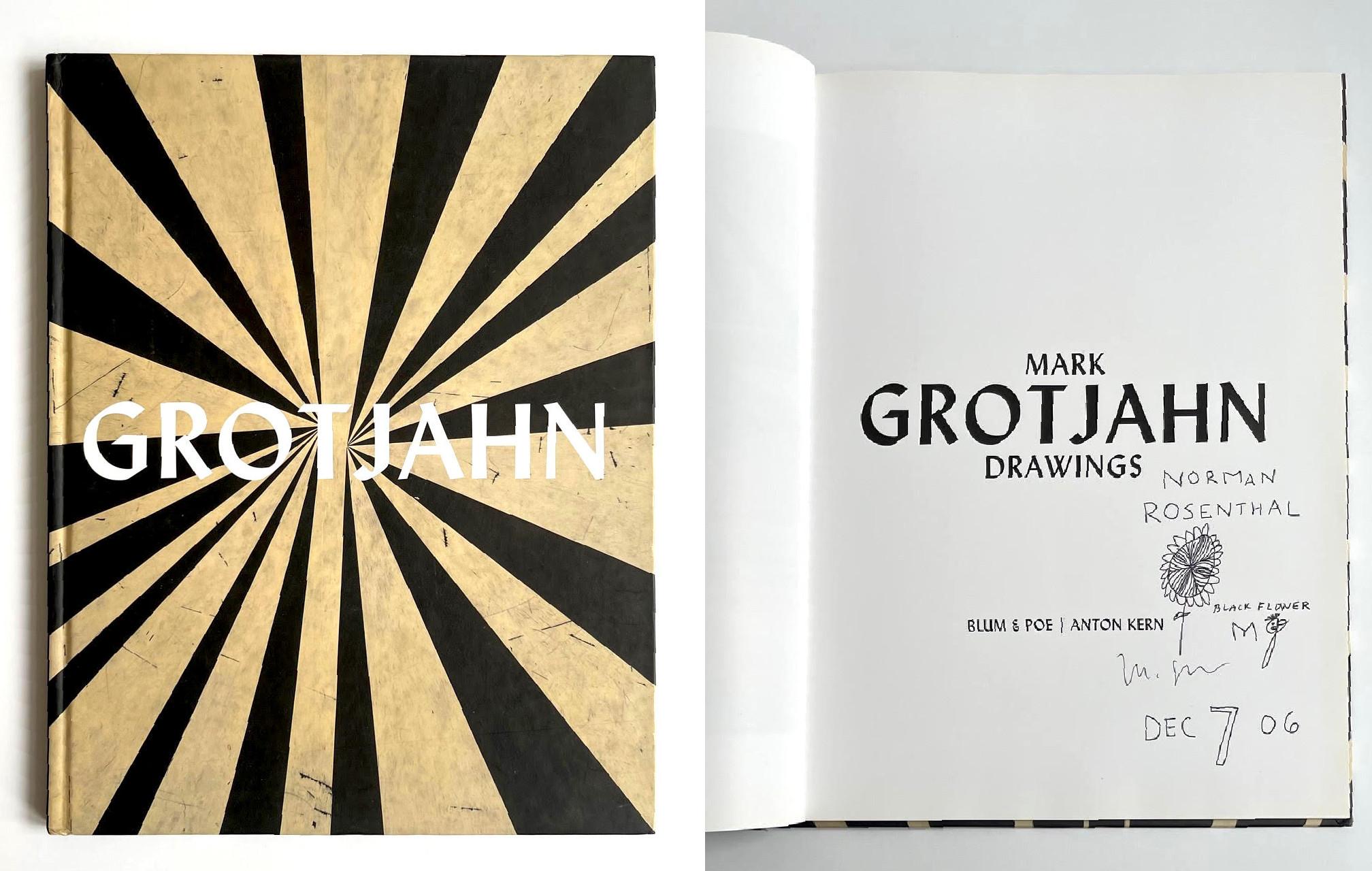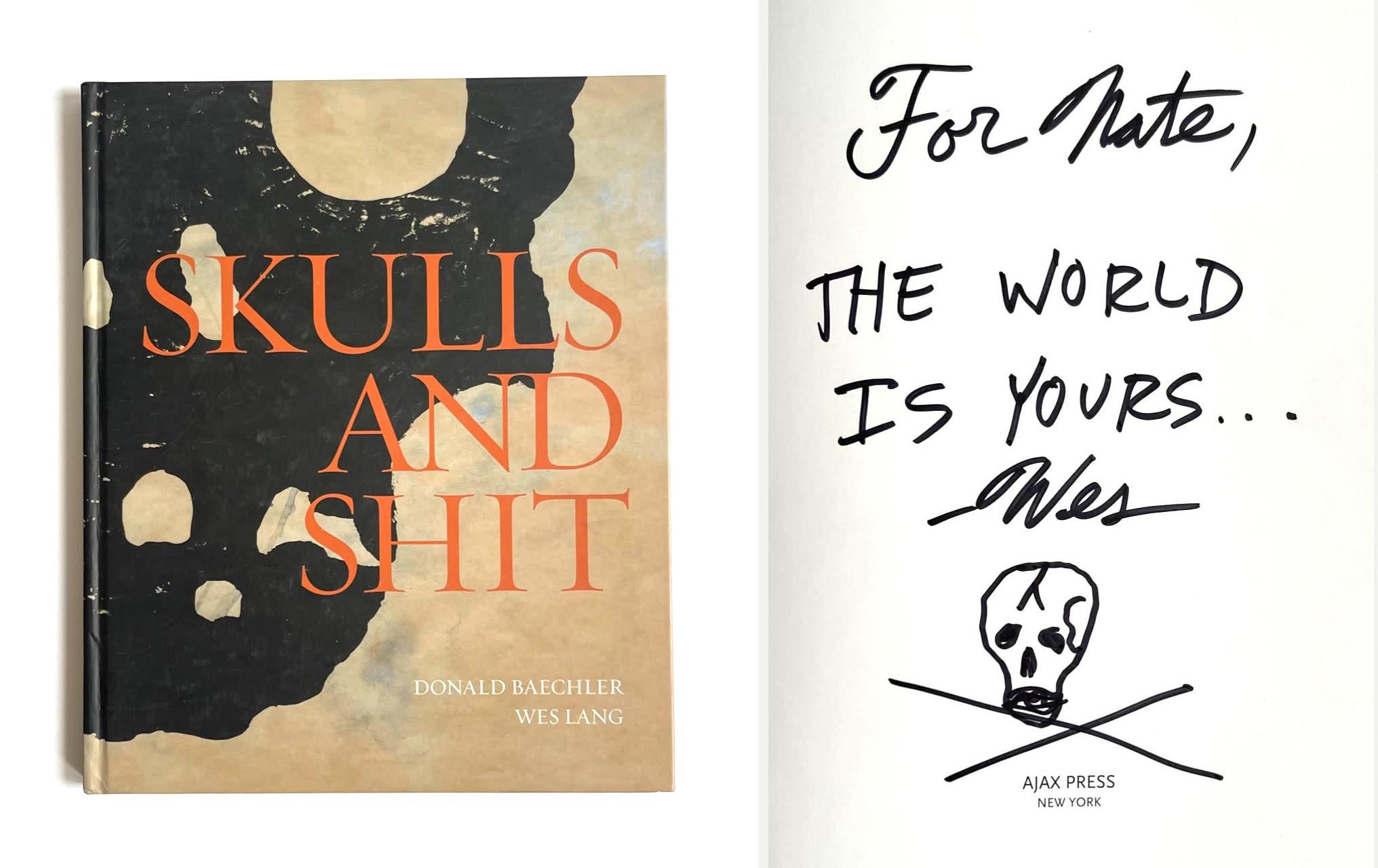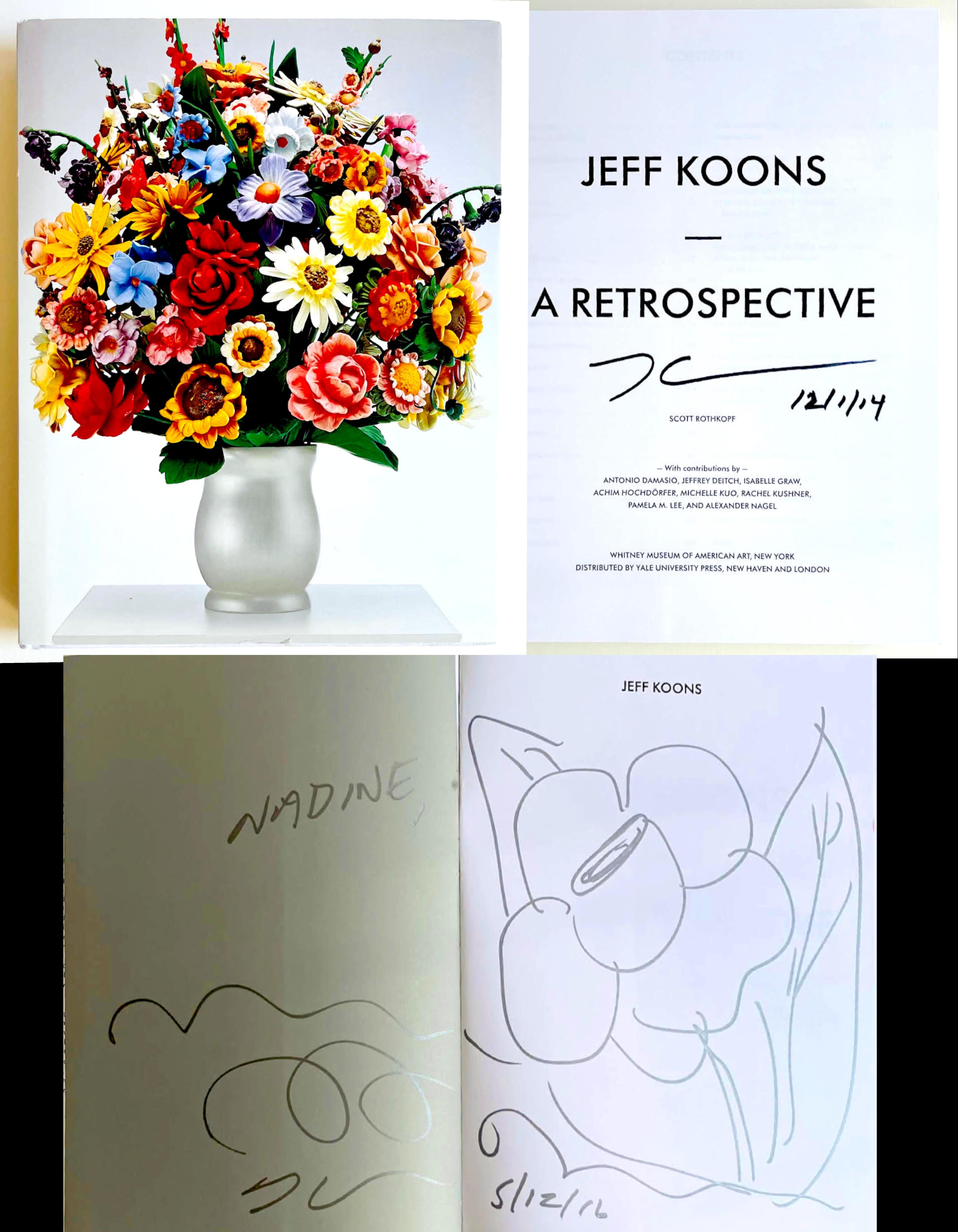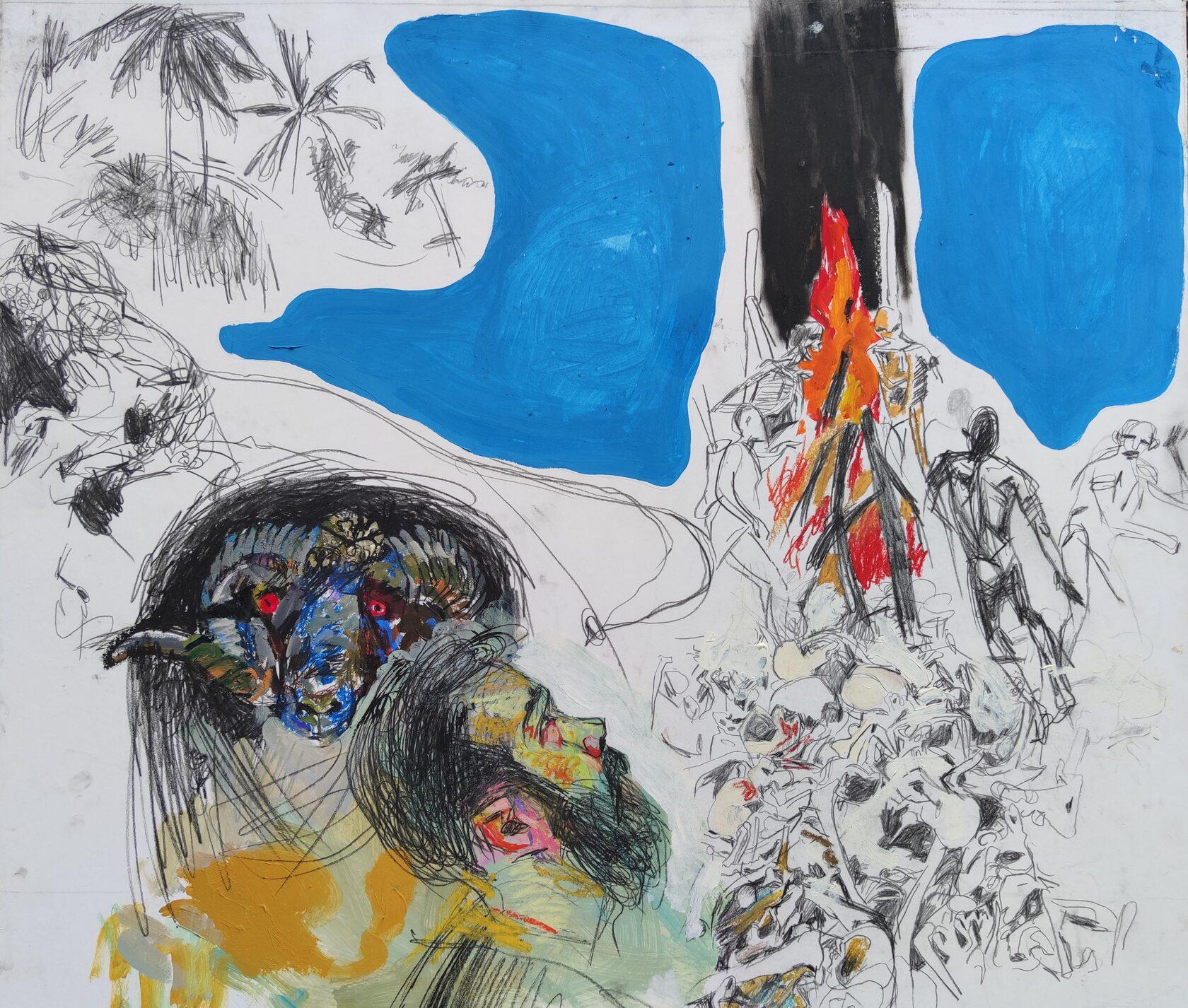Items Similar to Hand Signed Western Union cable re: sculpture show at famed Leo Castelli gallery
Want more images or videos?
Request additional images or videos from the seller
1 of 2
John ChamberlainHand Signed Western Union cable re: sculpture show at famed Leo Castelli gallery1982
1982
About the Item
John Chamberlain
Hand Signed Letter re: Leo Castelli Exhibition, 1982
Typewriter on paper (hand signed)
6 1/2 × 8 1/2 inches
Hand-signed by artist, Signed in purple felt tip marker
Hand signed telegraph/letter refers to Chamberlain's exhibition at the legendary Leo Castell Gallery.
A piece of history!
John Chamberlain Biography
John Chamberlain (1927 – 2011) was a quintessentially American artist, channeling the innovative power of the postwar years into a relentlessly inventive practice spanning six decades. He first achieved renown for sculptures made in the late 1950s through 1960s from automobile parts—these were path-breaking works that effectively transformed the gestural energy of Abstract Expressionist painting into three dimensions. Ranging in scale from miniature to monumental, Chamberlain’s compositions of twisted, crushed, and forged metal also bridged the divide between Process Art and Minimalism, drawing tenets of both into a new kinship. These singular works established him as one of the first American artists to determine color as a natural component of abstract sculpture. From the late 1960s until the end of his life, Chamberlain harnessed the expressive potential of an astonishing array of materials, which varied from Plexiglas, resin, and paint, to foam, aluminum foil, and paper bags.
After spending three years in the United States Navy during World War II, Chamberlain enrolled in the Art Institute of Chicago and Black Mountain College, where he developed the critical underpinnings of his work. Chamberlain lived and worked in many parts of the United States, moving between New York City, Long Island, Los Angeles, Santa Fe, Connecticut, and Sarasota, before finally settling on Shelter Island. In many ways, each location provoked a distinct material sensibility, often defined by the availability of that material or the limitations of physical space. In New York City, Chamberlain pulled scrap metal and twelve-inch acoustic tiles from the ceiling of his studio apartment. He chose urethane in Los Angeles in 1965 (a material he had been considering for many years), and film in Mexico in 1968. He eventually returned to metal in 1972, and, in Sarasota, he expanded the scale of his works to make his iconic Gondolas (1981 – 1982). The movement of the artist and the subsequent evolution of the work is indicative not only of a kind of American restlessness but also of Chamberlain’s own personal evolution: he sometimes described his use of automobile materials as sculptural self-portraits, infused with balance and rhythm characteristic of the artist himself.
Chamberlain refused to separate color from his practice, saying, ‘I never thought of sculpture without color. Do you see anything around that has no color? Do you live in a world with no color?’. He both honored and assigned value to color in his practice—in his early sculptures color was not added, but composed from the preexisting palette of his chosen automobile parts. Chamberlain later began adding color to metal in 1974, dripping and spraying—and sometimes sandblasting—paint and lacquer onto his metal components prior to their integration. With his polyurethane foam works, color was a variable of light: ultraviolet rays or sunlight turned the material from white to amber. It was this profound visual effect that brought the artist’s personal Abstract Expressionist hand into industrial three-dimensional sculpture. Chamberlain moved seamlessly through scale and volume, creating material explorations in monumental, heavy-gauge painted aluminum foil in the 1970s, and later in the 1980s and 1990s, miniatures in colorful aluminum foil and chromium painted steel.
Central to Chamberlain’s works is the notion that sculpture denotes a great deal of weight and physicality, disrupting whatever space it occupies. In the Barges series (1971 – 1983) he made immense foam couches, inviting spectators to lounge upon the cushioned landscape. At the end of his career, Chamberlain shifted his practice outdoors, and through a series of determined experiments, finally created brilliant, candy-colored sculptures in twisted aluminum foil. In 2012, four of these sculptures were shown outside the Seagram Building in New York, accompanied by playful titles such as ‘PINEAPPLESURPRISE’ (2010) and ‘MERMAIDSMISCHIEF’ (2009). These final works exemplify Chamberlain’s lifelong dedication to change—of his materials, of his practice, and, consequently, of American Art.
Chamberlain has been the subject of numerous solo exhibitions, including two major Retrospectives at the Solomon R. Guggenheim Museum in New York NY in 2012 and 1971; ‘John Chamberlain, Squeezed and Tied. Foam and Paper Sculptures 1969-70,’ Dan Flavin Art Institute, Dia Center for the Arts, Bridgehampton NY (2007); ‘John Chamberlain. Foam Sculptures 1966–1981, Photographs 1989–2004,’ Chinati Foundation, Marfa TX (2005); ‘John Chamberlain. Current Work and Fond Memories, Sculptures and Photographs 1967–1995,’ Stedelijk Museum, Amsterdam, Netherlands (Traveling Exhibition) (1996); and ‘John Chamberlain. Sculpture, 1954–1985,’ Museum of Contemporary Art, Los Angeles CA (1986). Chamberlain’s sculptures are part of permanent exhibitions at the Chinati Foundation in Marfa TX and at Dia:Beacon in upstate New York. In 1964, Chamberlain represented the United States in the American Pavilion at the 32nd International Exhibition of the Venice Biennale. He received many awards during his life, including a Doctor of Fine Arts, honoris causa, from the College for Creative Studies, Detroit (2010); the Distinction in Sculpture Honor from the Sculpture Center, New York (1999); the Gold Medal from The National Arts Club Award, New York (1997); the Lifetime Achievement Award in Contemporary Sculpture by the International Sculpture Center, Washington D.C. (1993); and the Skowhegan Medal for Sculpture, New York NY (1993).
-Courtesy Hauser & Wirth
Leo Castelli
Leo Castelli was born in 1907 in Trieste, a city on the Adriatic sea, which, at the time, was the main port of the Austro-Hungarian Empire. Leo’s father, Ernest Kraus, was the regional director for Austria-Hungary’s largest bank, the Kreditandstalt; his mother, Bianca Castelli, was the daughter of a Triesten coffee merchant.
With the outbreak of World War I in 1914 the Kraus family relocated to Vienna where Leo continued his education. A particularly memorable moment for Leo during this period of his life was the funeral of Emperor Francis Joseph which he witnessed in November of 1916. Leo and his family returned to Trieste when the war ended in 1918. With the fall of the Austro-Hungarian Empire Trieste embraced its new Italian identity. Motivated by this shift Ernest decided to adopt his wife's more Italian-sounding maiden name, Castelli, which his children also assumed.
In many ways the Castelli’s return Trieste after the war marked an optimistic new beginning for the family. Ernest was made director of the Banca Commerciale Italiana, which had replaced the Kreditandstalt as the top bank in Trieste. This elevated position allowed Ernest and Bianca to cultivate a cosmopolitan life-style. Together they hosted frequent parties which brought them in contact with a spectrum of political, financial, and cultural luminaries. Growing up in such an environment fostered in Leo and his two siblings, Silvia and Giorgio, a strong appreciation of high culture. During this time Leo developed a passion for Modern literature and perfected his fluency in German, French, Italian, and English.
After earning his law degree at the University of Milan in 1932, Leo began his adult life as an insurance agent in Bucharest. Although Leo found the job unfulfilling and tedious, the people he met in Bucharest made up for this deficiency. Among the most significant of Leo’s acquaintances during this time was the eminent businessman, Mihail Shapira. Leo eventually became friendly with the rest of the Shapira family and in 1933 he married Mihail's youngest daughter, Ileana.
In 1934 Leo and Ileana moved to Paris where, thanks to his step-father’s influence, Leo was able to get a job in the Paris branch of the Banca d'Italia. In the same year, Leo met the interior designer René Drouin, who became his close friend. In the spring of 1938, while walking through the Place Vendôme, Leo and René came across a storefront for rent between the Ritz hotel and a Schiaparelli boutique. The space immediately impressed them as an ideal location for an art gallery, a plan which became reality the following spring in 1939. The Drouin Gallery opened with an exhibition featuring painting and furniture by Surrealist artists including Léonor Fini, Augene Berman, Meret Oppenheim, Max Ernst, and Salvador Dali. Despite the success of this initial exhibition, the gallery proved short-lived. Germany invaded Poland on September 1, 1939 marking the start of World War II and consequently the temporary end of the Drouin gallery. René was called to serve in the French army, while Leo, Ileana, and their three-year-old daughter Nina moved to the relative safety of Cannes, where Ileana’s family owned a summer house.
As the war escalated, it became evident that Europe was no longer safe for the Castelli family—Leo and Ileana were both Jewish. In March of 1941, Leo, Ileana and Nina fled to New York bringing with them Nina’s nurse Frances and their dog, Noodle. After a year of moving around the city, the family took up permanent residence at 4 East 77 Street in a townhouse Mihail had bought. Nine months after his arrival in New York, in December of 1943, Leo volunteered for the US army, expediting his naturalization as a US citizen. Owing to his facility with languages, Leo was assigned to serve in the U.S. Army Intelligence Corp, a position which he held for two years, until February 1946.
While on military leave in 1945 Leo visited Paris and stopped by Place Vendôme gallery where René had once more set up business selling work by European avant-garde artists such as Jean Dubuffet and Jean Fautrier. The meeting not only rekindled René and Leo’s friendship but also the latter’s interest in art dealing, a pursuit which Leo began to view as more than a mere hobby but as a potential career. After reconnecting, the two friends decided to go back into partnership with Leo acting as the New York representative for the Drouin Gallery. Working in this capacity, Leo began to form relationships with some of the New York art world’s most influential figures, including Peggy Guggenhiem, Sydney Janis, Willem De Kooning, and Jackson Pollock.
By the late 40s Leo’s ties with René Drouin had begun to slacken, while his alliance with the dealer Sydney Janis became closer. Janis opened his New York gallery in 1948 and in 1950 invited Leo to curate an exhibition of contemporary French and American artists. The show drew a significant connection between the venerable tradition of European Modernism and the emerging artists of the New York School. Not long after this, in 1951, Leo was asked by these same New York School artists to organize the groundbreaking Ninth Street Show. This exhibition was instrumental in establishing Abstract Expressionism as the preeminent art movement of the post-war era.
Leo founded his own gallery in 1957, transforming the living room on the fourth floor of the 77th Street townhouse into an exhibition space. Perhaps the most critical moment of Leo’s career occurred later that year, when he first visited the studios of Robert Rauschenberg and Jasper Johns. In 1958 Leo gave Johns and Rauschenberg solo shows, in January and March respectively. For Johns, this was the first solo show of his career. These exhibitions received wide critical acclaim, solidifying Leo’s reputation not only as a dealer but as the arbiter of a new and important art movement.
Over the course of the 1960s Leo played a formative role in launching the careers of many of the most significant artists of the twentieth century including Roy Lichtenstein, Andy Warhol, Claes Oldenberg, Cy Twombly, Donald Judd, Dan Flavin, Robert Morris, Bruce Nauman, Richard Serra, Joseph Kosuth and Lawrence Weiner. Through his support of these artists Leo likewise helped cultivate and define the movements of Pop, Minimalism, Conceptual Art, and Post-Minimalism.
As business expanded over the course of the 60s and artistic trends shifted in favor of larger artworks, Leo realized that his townhouse gallery was not sufficient to meet these new demands. Indicative of the trend toward maximal art was the gallery’s exhibition of James Rosenquist’s seminal installation, F-111 in 1964. This multi-paneled, mural-sized work, inspired by billboard advertisements, filled the four walls of the gallery at 4 East 77, almost as if attempting to expand the space through its sheer immensity and dynamism. The rise of this type of art prompted Leo, in 1968, to acquire an industrial loft in Harlem which became known as the Castelli Warehouse. While he continued to hold more intimate exhibitions at the 4 East 77th Street gallery, the warehouse became a space for showcasing new media works such as Robert Morris’s Continuous Project Altered Daily (1969) and Keith Sonnier’s Dis-play II (1970).
Leo’s expansion of the gallery continued into the 1970s with the establishment of a new location in Soho at 420 West Broadway. As in the case of the warehouse, this move was motivated primarily by Leo’s desire to satisfy needs arising from new artistic developments. This time, however, Leo responded to the wave of experimental performance art and music which swept New York during the 70s and was largely driven by artists working in the city’s downtown neighborhoods. Leo intersected with this new current in art by hosting performances by a diverse range of artists including Joan Jonas, Poppy Johnson, Richard Landry, and Philip Glass.
The growth of the Castelli Gallery continued through the 80s and 90s. In 1980 Leo opened a second location in Soho at 142 Greene Street. Having closed the Castelli Warehouse in 1971, this new space became the gallery’s primary venue for exhibiting large-scale works. One of the most notable exhibitions held in this space was Roy Lichtenstien’s Greene Street Mural which opened December 3, 1983. For this unprecedented project, Lichtenstein painted the 18 x 96 ½ foot mural directly onto the walls of the gallery. When the show closed in January of 1984, the work was destroyed.
Over the course of his career, until his death on August 22, 1999, Leo maintained close working relationships with artists whose careers he had helped to make and who, in turn, helped to make his own career as a dealer. Jasper Johns, Roy Lichtenstein, and Bruce Nauman in particular are three artists who Leo discovered and who remained with the gallery until Leo’s death. This focus on working with artists in the long-term is also reflected in the many generous donations of artwork Leo made to high-caliber museums such as the Museum of Modern Art. These gifts testify to Leo’s deep interest not simply in cultivating the short-term value of art as a commodity, but on ensuring the cultural value of these works for all time.
-Courtesy Castelli
- Creator:John Chamberlain (1927, American)
- Creation Year:1982
- Dimensions:Height: 6.5 in (16.51 cm)Width: 8.5 in (21.59 cm)
- Medium:
- Movement & Style:
- Period:
- Condition:Very good vintage condition.
- Gallery Location:New York, NY
- Reference Number:1stDibs: LU1745210725712
About the Seller
5.0
Platinum Seller
These expertly vetted sellers are 1stDibs' most experienced sellers and are rated highest by our customers.
Established in 2007
1stDibs seller since 2022
289 sales on 1stDibs
Typical response time: 1 hour
- ShippingRetrieving quote...Ships From: New York, NY
- Return PolicyA return for this item may be initiated within 1 day of delivery.
More From This SellerView All
- CAT (original drawing)By Walasse TingLocated in New York, NYWalasse Ting 丁雄泉 CAT (original drawing), 1985 Original Ink and Marker on offset lithograph held in hardback monograph Hand signed and inscribed by the artist This is an absolutely gorgeous drawing of a cat by the pioneering Chinese-American-European artist Walasse Ting, who famously collaborated with Sam Francis and many other Ab Ex, Pop and COBRA artists. (He was the brainchild behind the legendary One Cent Life portfolio). Ting was also, famously, a cat lover, and is renowned for his expressive, colorful and gorgeous drawings of cats...Category
1980s Abstract Animal Drawings and Watercolors
MaterialsInk, Mixed Media, Permanent Marker, Offset
- "This should help you with the difficult Mr. Buckley" handwritten, signed letterBy Norman RockwellLocated in New York, NYNorman Rockwell "This should help you with the difficult Mr. Buckley", ca 1965 Hand written and hand signed letter on artist's personalized stationery with the accompanying stamped and postmarked envelope. Frame Included Unique. Vintage handwritten...Category
Mid-20th Century Realist Figurative Drawings and Watercolors
MaterialsInk, Newsprint, Lithograph, Offset, Mixed Media
- Signed Flower drawing in monograph, inscribed to art historian Norman RosenthalBy Mark GrotjahnLocated in New York, NYMark Grotjahn Black Flower (inscribed to art historian Norman Rosenthal), 2006 Original flower drawing done in black marker, hand signed, titled and inscribed, bound in hardback mono...Category
2010s Contemporary Figurative Drawings and Watercolors
MaterialsOffset, Ink, Mixed Media, Lithograph
- Untitled original signed drawing ("The Lovers")By Marina AbramovicLocated in New York, NYMarina Abramovic The Lovers, 1990 Original Drawing done in Black Marker on title page of the "Lovers" monograph Hand signed by Marina Abramovic in black mar...Category
1990s Contemporary Mixed Media
MaterialsPrinter's Ink, Permanent Marker, Mixed Media, Offset, Board, Lithograph
- Original self-portrait drawing (hand signed and inscribed)By Marina AbramovicLocated in New York, NYMarina Abramovic Original self-portrait drawing (hand signed and inscribed), 2014 Ink drawing held inside hardback monograph, done at the artist's Serpentine Gallery exhibition, han...Category
2010s Contemporary Figurative Drawings and Watercolors
MaterialsInk, Lithograph, Offset
- Original bird drawing (hand signed and inscribed by Ronnie Cutrone) in monographBy Ronnie CutroneLocated in New York, NYRonnie Cutrone Original bird drawing (hand signed and inscribed by Ronnie Cutrone), 1990 Original signed drawing done in marker held in hardback monograph with dust jacket Boldly signed, dated and inscribed by Ronnie Cutrone on the first front end page 11 × 9 1/2 × 3/4 inches Original signed drawing done in marker held in monograph, dated and inscribed by Ronnie Cutrone on the first front end page. The inscription reads: For David & Barbara Ronnie Cutrone 90 Book information: Publisher: Martin Lawrence Limited Editions, (January 1, 1990) English; Hardcover; 46 pages with 44 color and 11 monochrome illustrations About Ronnie Cutrone: Ronnie Cutrone (July 10, 1948 – July 21, 2013) was an American pop artist known for his large-scale paintings of some of America's favorite cartoon characters, such as Felix the Cat, Pink Panther, Woody Woodpecker and No Glove No Love. Cutrone's paintings are colorful, lively, and less challenging than those of his contemporaries. As Andy Warhol's assistant at the Factory atop the Decker Building from 1972 until 1980, Cutrone worked with Warhol on paintings, prints, films, and other concepts, eventually co-opting Warhol's earliest work (pre-1960) as well as works by Roy Lichtenstein and others, until finally distilling those myriad influences into the style a few critics eventually labeled "Post-Pop." He exhibited at the Niveau Gallery in 1979 with a Scottish artist called Mike Gall who showed paintings of Snoopy, Mickey and Minnie mouse, the Pink Panther and also a small series of Peter Rabbit paintings...Category
1990s Pop Art Animal Drawings and Watercolors
MaterialsInk, Mixed Media, Permanent Marker, Lithograph, Offset, Paper
You May Also Like
- Work from the series “Robinson Crusoe. A story of loneliness ” 71x80cmBy Viktoriya KadesnikovaLocated in Yerevan, AMWork from the series “Robinson Crusoe. A story of loneliness ” 71x80 cmCategory
2010s Abstract Impressionist Figurative Drawings and Watercolors
MaterialsPaper, Oil Crayon, Acrylic
- Circus Clown and GuitaristLocated in Milford, NHA fine graphite drawing of a circus clown with guitarist by British / Canadian artist Jack Leonard Shadbolt (1909-1998). Shadbolt was born in Sho...Category
1940s Abstract Expressionist Figurative Drawings and Watercolors
MaterialsPaper, Graphite
- Volvo 164 - XXI Century, Contemporary Watercolor & Ink Painting, Vintage CarBy Mariusz SzałajdewiczLocated in Warsaw, PLMariusz Szalajdewicz (b. 1974) Studied at the Faculty of Architecture at Warsaw University of Technology, where he mastered the drawing skill. Arc...Category
21st Century and Contemporary Realist Figurative Drawings and Watercolors
MaterialsPaper, Ink, Watercolor
- School 1994, paper, ink, 15.2x19 cmLocated in Riga, LVSchool 1994, paper, ink, 15,2x19 cm Illustrated in the magazine "School and Family" in 1994.Category
1990s Modern Figurative Drawings and Watercolors
MaterialsPaper, Ink
- It happened ... Paper, ink, pencil, 20x26 cmLocated in Riga, LVIt happened ... Paper, ink, pencil, 20x26 cm As a black and white comic, the absence of color allows the artist to focus on using shading, line work, and contrast to convey the narrative and emotions effectively. Black and white comics creates a distinct and dramatic atmosphere, emphasizing the story's mood and capturing the readers' attention. Ivars Poikans 1952. Riga Ivars Poikāns works in painting, graphics, book illustration, cinema art...Category
1980s Modern Figurative Drawings and Watercolors
MaterialsPaper, Ink, Pencil
- Overboard... 1994. Paper, ink. 17x25 cmLocated in Riga, LVOverboard... 1994. Paper, ink. 17x25 cm Illustrated in the magazine "School and Family" in 1994.Category
1990s Modern Figurative Drawings and Watercolors
MaterialsPaper, Ink
Recently Viewed
View AllMore Ways To Browse
Hand Signed
Vintage Hand Sign
Hand Signed By Artist
Union Sign
Western Drawings
Western Art Drawings
Vintage Western Signs
Vintage Western Sign
Vintage Western Paper
Western Watercolors
Art Western Watercolor
Leo Castelli
Western Union
Castelli Signed
Chamberlain John
Vintage Western Union
Typewriter Painting
Typewriter Print





